It’s all about your brain. Your brain is the command center of your body. All of your actions are ultimate processed by your brain and nervous system. But your brain is made up of multiple individual “brains”. Each of which has different responsibilities and behave in differing ways. Sometimes, these brains work in harmony, sometimes they are in conflict.
In this Learning MAP, Marc MacYoung, Rory Miller, and Erik Kondo use their models to explain how the three brains effect your ability to manage conflict and protect yourself from danger.
Marc MacYoung
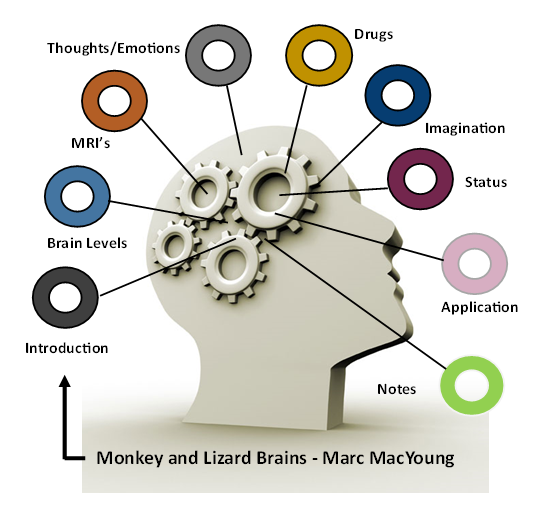
Introduction to the Levels of Your Brain
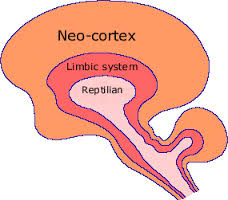
You may think you know what's going on inside your head, but simply put, you're like a captain of a ship standing on the bridge. You may be able to see what's happening on the ocean in front of you, but there's a lot of stuff going on you can't see. This includes what's aft and -- most of all -- what's happening below decks.
These are things going on in your 'ship' that you not only take for granted, but in fact, don't even know are going on. And that includes drug use, animals running around and even potential mutiny.
You didn't receive your brain from some internet supply source. Nor was it pre-packaged and installed by some divine super-being that put you above all animals. Your brain is the result of millions of years of evolution. Our species spent a long time fighting for survival and dominance against animals that were bigger, stronger, faster and better equipped than us. And when we were dealing with different species, we turned our attention to each other.
There's a whole lot of hardware that effects how the software runs. Not only that, but there's all kinds of chemicals, wiring and design modifications that keep the whole things chugging along.
What follows is an introduction to an extremely complex subject. It isn't a explanation of how you're going to react. It is layman's explanation of WHAT is going on inside you ... once you understand that, then you can begin to understand why it is so important and how it will effect your decisions and perceptions -- and by extension, your actions.
Simply put, You better learn how to work with these different aspects of yourself, your chemical/primate/unconscious/emotional patterns to stay in charge of your own ship. Realistically, there's more to being a captain of a ship than just standing on the bridge. This page is an introduction to what's going on in the rest of the ship. If you don't have an idea of what is going on inside of you can't control what you do.
And if you can't control what you're doing, you certainly can't control what is happening outside. While that may not sound like much of a problem, realize that there's a BIG difference between controlling external circumstances and influencing them. You may not be able to control whether or not someone attacks, but your out of control emotions can certainly provoke an attack.
In his excellent book Meditations on Violence, Rory Miller coined a term describing behavioral patterns that lead to violence. He called it "The Monkey Dance."
We cannot say enough about Rory's book anyway, but that is nothing in comparison to how important the monkey dance concept is. It is an idea that cannot only save your life, but it will reduce conflicts and strife in your life.
And if a situation does go violent, it can do wonders for keeping you out of prison. You want to stay out of the monkey dance. That page quote tells you why.
A short explanation of the monkey dance is it's the primate conflict behavior patterns for social dominance that we -- as humans -- ALSO follow.
When we drop into our emotional/monkey brain -- although we think we are being rational -- we literally become excited monkeys. Watch some clips of monkeys in conflict and try to tell yourself you haven't seen the same behavior with humans too(1). This is not anthropomorphizing, human do the same behaviors, but with more grey cells.
What follows is a generalized layman's explanation of how your brain is put together and how it creates, affects and effects your behavior -- especially when it comes to conflict, aggression, fear and the monkey dance.
Video Link:
Levels of Your Brain

Every night you go to bed with a human, a monkey and a lizard. No we're not saying that you are kinky. Nor are we insulting your significant other. What we are talking about are analogies of the different levels of your brain.
Although not exactly accurate, a useful rule of thumb goes:
- Neo-cortex = human brain
- Limbic system = monkey brain
- Cerebellum = lizard brain
The Neo-cortex controls rational thought, speaking and other higher brain functions.
The limbic system controls emotions and a whole lot more.
The Cerebellum controls movement. action and body functions.
Each of these levels not only were important for our species evolution, but they handle different jobs. You don't have to think about breathing because your lizard brain takes care of it for you. It also keeps your heart beating. (Oh good, one less thing to worry about.) It's also real good at telling you when to eat, have sex and run.
Your monkey brain patterns your emotional responses and helps guide you through social interactions. This is where our primate social behavioral patterns are rooted. It could be said these patterns are less about 'psychology' than they are about the hardwiring of the humans to behave the way we do(1).
Technically speaking the monkey and the lizard don't 'think' -- at least not in the sense of rational and logical thought. While they do process, they are a lot more action and emotionally oriented. They're big on doing. And given the right stimulus they will jump behind the wheel and drive the bus.
The neo-cortex seldom totally abandons us. This is why even someone who is exceedingly drunk can still talk. But that doesn't mean we are functioning in that part of our brain. Or that our behaviors are rational, logical or even under our conscious control.
Video Links
MRI's and the Monkey Brain
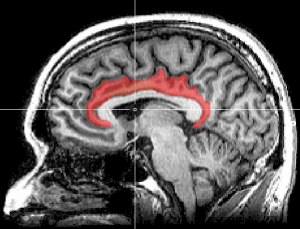
Dr Drew Westen of Emory University (author of "The Political Brain") ran an interesting experiment where he took individuals -- who identified themselves as either liberal or conservative -- and put them into an MRI machine. The MRI was focused on their brains. Westen then proceeded to ask them political questions.
Interestingly enough, in both groups the part of the brain showed activity was NOT the rational, but rather the emotional parts (limbic system). There it was on the screen. That part of their brain is active, not the other part.
What is of equal interest is while these groups were diametrically opposed in political views, they both exhibited the same behavior patterns -- especially when it came to bias. For example they were extremely condemning of the opposition candidate for wrong doing and equally overly-forgiving when their candidate did the exact same thing. In neither case did the punishment fit the 'crime.'
Here's the real kicker. Despite the researchers looking at the physical proof that these people were being emotional, not logical, the participants ALL swore that they were being logical and reasonable in their 'thinking.' (News release).
Now you know why talking politics and religion can get so heated.
This study has incredible implications because it show how often someone's 'thinking' is emotional, not logical. And if we think we're being rational when we are operating in our limbic system, then how do we know we AREN'T following primate conflict behavior when we're emotional as well?
Thoughts Precede Emotions

Here is where we run into a "which came first, the chicken or the egg" problem.
While the monkey brain doesn't exactly 'think,' it does process emotionally. Where it starts getting complicated is in a generalized way 'thoughts precede emotions.' But not necessarily in 'the more I think about it the madder I get' sense (although that is part of it too).
A huge factor is 'how you think in the long term' directs your emotional responses.
We're not talking about a single thought here (e.g. the cat knocked the glass over). What we're talking about is your long established thought patterns determine your emotions. How you think directs how you feel.
Imagine your emotions like water. These long term 'thinking patterns' channel your emotions (and thoughts) down certain pathways. And this happens without you consciously knowing it. Like rain running off a roof and down a drain spout, you only become aware of it when it comes gushing out.
Have you ever had an emotion faster than conscious thought? Who hasn't? Someone says something and you're immediately angry. Then you have a moment to 'think about it' and you calm down -- when you realize that the person didn't mean what you thought he said. That is an example of emotional processing being guided down certain pathways and you consciously stopping the process.
Often however, people DON'T stop the process, they just react as if their feelings reflect actuality. Not only that, but they react as though their emotions are conscious and rational. (Have you ever told someone to be reasonable and they hysterically scream "I AM BEING REASONABLE!"?)
How we 'think' effects what emotions come out of us. And often our emotions are powering our behaviors. When we are in an emotional state, we can't tell whether what we are doing is appropriate or not because -- to us -- it seems like the absolute right thing to do given the circumstances. In fact, we often pat ourselves on the back for not taking it further.
Now to really muck things up, there is another complication. That is: How you think physically rewires your brain!
The 'channels' in your thought (your established way of thinking) actually physically alters your brain. In the same way that arroyos in the desert can be carved by running water -- and in doing so force water to run down these pathways -- there is evidence it happens in your brain too. You can wire yourself so you HAVE to think a certain way.
When these pathways are entrenched, like a flash flood in the desert, your thoughts and emotions will be dragged down these pathways. Whether you want them to or not!
Daniel Goleman in his book Emotional Intelligence talks about 'emotional hijackings where this process drags people away from rational thought. But again -- and I can't stress this enough -- most people don't mind going down these paths because they think they are 'right.'
They honestly believe they are responding correctly to the stimulus that they are receiving and never questioning if what they are perceiving and interpreting is what is actually occurring (e.g. if the comment they are taking as intentionally malicious and hurtful was, in fact, meant that way).
We call this "the monkey is driving the bus."
The Monkey Brain Swings Into Action
Let's use something we've already said to show you how this works. We said "the cat knocked over the glass." That painted an 'image' in the mind. Did you have an emotional response?
Why?
First off it is a fictitious event. However, it is based on an experience many people have.
Second, the statement itself was neutral. But, did YOU personalize it? Was it your drink you imagined being knocked over? Was it your property being damaged? Was it your cat -- that you care about? In which case your anger is tempered with your fondness of the cat. Was it a cat you don't like, in which your anger was increased. Or was it your neighbor's cat, in her house, her property being damaged and her drink -- so you really have no emotional investment at all?
Or, and this is common for people who don't have a cat, did you remain uninvolved emotionally knowing it was a hypothetical example?
We used this example to make an important point. That is we want you to realize is how closely linked your emotions are to your imagination.
Drugs, Drugs, Drugs

Here's an interesting bit of trivia. Any drug you can take mimics a hormone or chemical that your body already produces. Among the many other things it does, your body is a complex chemical manufacturing plant. When you're healthy, it's an in house process. What medicine does is it enhances or takes over when this in-house process malfunctions or can't keep up.
Not only our health, but our mental stability is strongly influenced with how well our internal chemical factory is working. When you drink alcohol, smoke a cigarette, do drugs, have sex, pet an animal and even eat, you are consciously choosing a course of action that affects the chemical balance within your body (2). In some of those cases you are actively introducing desired chemicals in others the chemical change is a result.
These changes in your chemical balance are going to effect all kinds of things -- especially in your brain. This brings us to a HUGE 'which came first the chicken or the egg?' issue. Which came first, chemical paths, neural pathways or emotions?
What we can for sure is what came next is your behaviors.
The big question is: Were those behaviors appropriate for the external environment?
Let's go back to the lizard and monkey brains. Another thing they are BOTH are big on is triggering the chemical baths that strongly influence our behavior. You get stimuli that those parts are wired for and BAM! instant hormone dump.
But that doesn't stop us from believing that we are thinking and being reasonable when they are 'driving the bus.' Oh yeah, and that monkey? He just did a line of cocaine before he got behind the steering wheel.
This is where our perceptions get skewed. Inside of our heads, we are convinced that "IT IS HAPPENING!" It doesn't matter what is actually happening, in our reality it is real. Except our 'reality' is as often a monkey having hallucinations as it is an accurate interpretation of what is going on in front of us.
Your emotions both create and are driven by these chemicals inside of you. This creates an ongoing cycle within you that if you don't control, it will control you.
Going back to the Captain of the ship analogy, if the engine shuts down it doesn't matter what the captain wants. It's what happens with the engine that is going to determine if the ship is going anywhere. In the same vein, if the engine suddenly gets stuck at full throttle and there's panic in the below decks, that ship ain't going to slow down no matter how much the captain yells and screams for everyone to remain calm.
Imagination As An Evolutionary Survival Trait

It is not uncommon in Western societies to try to suppress and down play the the imagination. Children are told to come out of their imaginations and focus on the 'real world.'
In light of what we are about to tell you, we find that rather ironic.
There is a theory in evolutionary psychology that 'imagination' is a more functional and versatile mechanism than 'instincts.'
According to this theory, it is imagination, not instincts that has allowed human beings to migrate to, adapt and survive to every continent and environment on this planet.
How? There is a crab that lives on the west coast of Italy. These crabs lay eggs on the beach and when they hatch, the young crabs unerringly find their way to the ocean. For years scientists tried to figure they did this. How do young crabs know to find the ocean? How do they know which direction to go?
In an experiment a batch of eggs were taken to the east coast of Italy and allowed to hatch.
The hatchlings proceeded to try to march over the Italian peninsula. The crabs weren't heading 'towards the water,' their instincts forced to march west. As long as the species stayed on the west coast, this was a functional instinct.
You could take the crabs to the same temperate climate anywhere in the world and -- as long as you put them on the west coast -- the odds are good the colony would survive. But they'd die if put on the north, east or south coast. That's because their instincts MAKE them go west when hatched.
That is an example of instincts. It is the the ingrained compelling of an organism to perform certain actions to function in specific environments. If the environment changes, the species dies.
Imagination however, is another survival mechanism. Let's say your ancestors come from a seasonal cold weather environment. Someone way back when figured out:
This white cold stuff comes every year and when it does food is scarce. On the other hand, right now everything is green and there's lots of food.
It was imagination, not instincts, that started your ancestors gathering and storing food for winter. The rational brain may have come up with the strategy of storing food, but the imagination was what told us there was a need. And a need at a time when there wasn't(2).
We used the cold weather survival analogy to show you how powerful a survival mechanism imagination is over instincts.
If your ancestors were not from a cold weather environment, then the coping strategies they came up with in a different climate are entirely different. A strategy that was equally successful for meeting the challenges there. But again, based on imagining needs at a time when they weren't pressing.
Although the exact location of daydreaming is unknown (different parts all light up), some experts say where it happens is part of the limbic system. But, for the ease of explanation, let's say that imagination is closely linked with your monkey brain.
Your monkey brain has one hell of an imagination.
We say this especially in light of how many times our emotions are linked to what we imagine. Our imagination projects into the future. Our emotions spur us to act on what we imagine.
For example: If you see your child playing with matches inside the house and near drapes, your emotional reaction is over what might happen (the house burning down). This instead of what is actually happening.
Contrast this with your actions if the drapes are already on fire. When imagination has become reality, THAT'S when your lizard brain kicks in.
While they are both very 'now' oriented there is a very important difference here. Your monkey brain is afraid of what could result from what is happening now. Your lizard brain reacts to the danger of what is happening now.
The problem with imagination, however, is that if left unchecked by practicality and experience, it can easily turn into fantasy. And fantasy often triggers the monkey brain and the adrenal response to send someone out into la-la land with what they think they know.
Video Links
Dominance, Status, Pride and Self-Worth

We have an entire section based on alpha behavior and how many people get it wrong. This misunderstanding of what leadership is the source of all kinds of conflict and stress when someone who isn't qualified tries to 'run' the group.
Another section that we highly recommend you visit is the Kinds of Violence that shows how violence occurs. And how often it is a tool to maintain boundaries and social order so everyone can get by.
Both of these topics strongly influence the following information.
Let us start by pointing out that human beings are social animals. By this we don't mean whether or not you like being with people or not. We're talking that your survival and the survival of everyone else on this planet depends not only on other people, but the collective knowledge of millions of years.
The example we use is if you take a wild badger and drop it into a forest anywhere in the temperate zone that badgers exist in, it's going to get along just fine. On the other hand, if you took a human being and dropped him or her naked into the forest, odds are good that within a week that person would be dead.
On the other hand, if you equipped and trained that person, then his or her odds of survival would increase. BUT where did that training, knowledge, equipment and knowledge how to manufacture that equipment come from? The answer is other people. Even if you taught that person how to nap flint and other primitive survival skills, that knowledge came from other people. This knowledge came from people who lived and functioned in groups and it was communicated to him by people who do so now.
This is why we say we NEED other humans in order to survive.
Now anytime primates live together in a group, certain issues arise. These issues also arise in human groups. But over and above basic primate behaviors further complications exist among humans. How these issues are addressed within a certain group is the basis for different cultures(3).
But let's take this down to a more 'survival is not guaranteed' level. That 'tribe' over there is a threat. They want the same resources that we need to survive. If we lose control over our resources, we are well and truly screwed. Worse, they are willing to work together to try to chase us away. In order to prevent that, we must at the least match their number of fighters.
So here is the primate challenge, how do we establish a hierarchy among OUR fighters, but without chasing them away or injuring them -- which would weaken our ability to hold off another tribe? If you want to make it even more complicated, how do we train and encourage the aggressiveness needed to fight others, but keep it from turning on everyone in the tribe?
The conscious answers are things like aggressive sports (especially martial sports) and a code of conduct (e.g. machisimo, bushido and chivalry). These are closely tied in with issues of status and respect -- provided that the person follows the rules of the code. The evolutionary and unconscious answer is the monkey dance. A complex set of patterns that involve lots of yelling and screaming, threat displays, short clashes followed by more yelling, screaming and threat displays. A process that while everyone is adrenalized, the purpose is NOT to hurt the other person. That is another kind of violence all together.
Can the monkey dance morph into these other kinds of violence? You betcha, especially among young, selfish and angry males who lack understanding about boundaries and what it really means to be an alpha.
Where the subject really spins out into unpredictability is when the person falsely believes that violence will bolster his self-esteem and gain him respect. Such people can either become obsessed with the idea of violence or become so violent (and so often) that the only safe way to deal with him is to either kill him or lock him in prison. No matter what cause for violence they use their violence tends to become predatorial as they try to compensate for their emotional weakness.
The way we look at it, this takes the violence out of the monkey dance and into other modes of behavior. We tend to look at this behavioral pattern akin to a property. At first you can run onto it and, while you can stay there, you can also keep on running through it. This takes you onto a different property. There are no physical fences in your mind that keep you from crossing property lines.
However, Rory has a slightly different interpretation. For example, in Meditations on Violence Rory also has a term, 'group monkey dance.' This is where, in order to 'prove' their allegiance to the group, individuals escalate their violence -- on an outsider -- to extremes. There is a complex dynamic here, not the least of which is that the 'group' must be present to witness the display of loyalty.
Video Links
Applying This To Conflict, Physical and Emotional Self-Defense
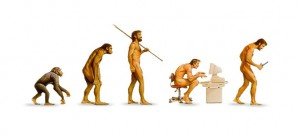
So how does all of this apply to self-defense, personal safety, adrenal stress, fighting, conflict resolution and de-escalation?
Man ... where DOESN'T IT?
Let's start with the fact that you're sitting there reading this means that for over two million years your ancestors managed to 'get up the tree before the leopard got them.' At least they managed to breed before this theoretical 'leopard' got them. Those that succeeded passed on traits that allowed the next generation to succeed in dangerous environments. Included in these traits being passed on is the ability to hand over the 'driving of the car' to the more survival oriented parts of the brain when danger showed up.
Now you may live in a civilized and generally stable environment, but that doesn't mean that your monkey brain does. You've got millions of years of not only evolution, but also evolutionary psychology, constantly percolating beneath your consciousness. And all it takes is a bump in the road to have it try to grab the steering wheel -- because it thinks its going to save you.
The problem with this is you have these 'giant guns' that are designed to allow you to deal with lions, tigers, bears and invading other tribes, but the biggest challenge most people face is emotional self-defense.
That's right. The worst threat the average civilized person faces is someone hurting his or her feelings. Or worse yet, self-esteem when the person feels he or she is not being respected. And it is definitely the most common way the monkey brain swings into action.
The problem with a monkey brain that isn't accustomed to dealing with physical danger is that it tends to accord emotional threats (or imagined ones) with the same sense of danger it would lions, tigers, et al. This can also apply to people with PTSD -- where once the danger was real, but not now. Yet the person still reacts as though a social issue is a matter of life or death.
If you don't want to be controlled by the monkey dance, then YOU need to understand how we are evolutionarily programmed to follow it. It is our default setting! But it is NOT our only setting. Instead of being sucked into an emotional hijacking, you want to be the one in control of yourself and your actions.
The problem with the monkey brain driving the car is it is entirely too easy to cross a line. And this especially true when it comes to crossing the line from self-defense into aggression, anger, illegal brutality, trying to gain self-respect through violence and fighting. While your monkey brain is telling you're doing the 'right thing' -- or that what you're IS self-defense -- there is a good chance that you're really doing is letting your monkey brain steer the car.
And then people wonder why they got into a crash.
Video Links:
Notes
1) Here are some clips of primates in conflict. Watch them and see if you can't see the same dynamics in a high school fight -- especially the threat display, clash, further threat display pattern:
Monkey Fight 1
Monkey Fight 2
Monkey Fight 3 (gorillas)
Including rat packing Monkey Fight 4
2) Now you might argue that certain cold weather squirrels also store food, so doesn't that show they have imagination instead of instincts? Well no because, at a certain point in the summer, a cold weather squirrel will instinctively start to gather and store food no matter where it is (e.g. in a zoo in Florida). Return to Text
3) The study of which gives us Cultural Anthropology. Using Theodore Sturgeon's "Law" about writing '90% of SF is crud.' we can look at different societies in the light of: There is a core 10% of issues that MUST be addressed by humans living in a group. How a large group of people handle those is the 90% that make up a particular culture.
A common problem, however, is when people mistake their 90% as the ONLY way to address the 10%. This especially applies when that local 90% is deemed as 'God's mandate.' Or Allah's. Both are serious examples of the monkey brain 'driving the car' while claiming it is 'thinking.' There are MANY ways to handle these issues, but the monkey brain has a preferred one. Oh yeah, while we're at it the same monkey thinking applies to so-called humanist ideology (politically correct thinking). In it's own way, it is just as irrational and unreasoning as a religious fanatic.
Marc MacYoung

Growing up on the gang-infested streets of Los Angeles not only gave Marc MacYoung his street name “Animal,” but also extensive firsthand experience about what does and does not work for self-defense. What he teaches is based on experience and has proven reliability for surviving violence. If it didn’t work, he wouldn’t be alive to talk about it.
He is considered by many to be one of the most analytical thinkers on the subject of surviving violence and personal safety today. He has taught police, military, martial artists and civilians around the world. His message is always the same: Hand-to-hand combat is a last ditch effort when other, more effective, preventive measures have failed.
Rory Miller
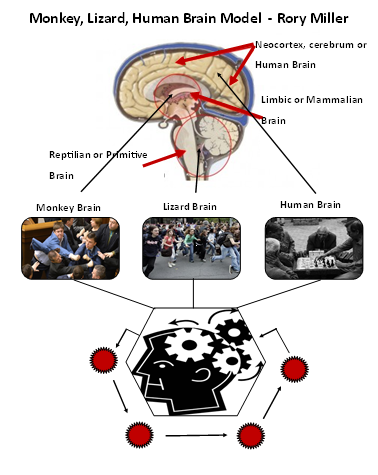
Introduction to the Lizard, Monkey, Human Brains
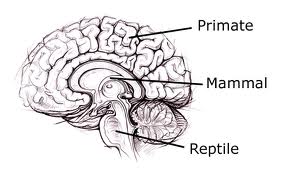
There will be some scientific details in what follows. Feel free to ignore it. Unless you are doing research, the background science is not important. The concepts are. And you know what? I’m not a scientist, so don’t take my word on anything.
Again, like Maslow, this is a model, not a theory. Many models are useful, none are TRUE.
For our purposes you have three brains, which we will call the Lizard, the Monkey and the Human.
You have three different brains with three different priorities. They evolved to deal with different kinds of conflict. They work using different scripts. They also have a very clear seniority system.
The Monkey Brain
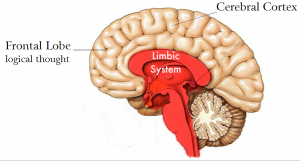
The Monkey brain corresponds to the limbic system, the emotional brain. The Monkey is completely concerned with social behavior, with status and what other people might think. The Monkey cannot distinguish between humiliation and death.
For much of our evolution, being cast out of the tribe was to be sentenced to a slow and lonely death. The Monkey knows this and fears being ostracized above all things. Soldiers could not be relied on in wartime if the fear of being laughed at as a coward didn’t override the fear of death.
You will see the power of the Monkey in dangerous situations. In natural disasters or major events such as the Twin Towers destruction, people were milling around, talking to each other, seeing what the other monkeys were going to do. In Baghdad, when an explosion went off near by, some people would hit the floor. Some (who had been there a while and could judge distance and safety) pretty much ignored it. Most looked around to see what they were supposed to do.
Because most of the conflict we experience comes from this level, the Monkey scripts drive a lot of current human conflict behavior.
The Monkey is concerned with social survival and status. It literally cannot distinguish between humiliation and death.
This is a key point in many very serious issues. At a low level, you can see it in action by taking a group of friends out bungee jumping. Fear of falling is one of the two fears that appeared to be hard-wired into human infants (the other is loud noises). In bungee jumping there is a small but real risk of injury. It usually takes a few minutes of cajoling to get a timid person to jump. A risk taker or adrenaline junkie will not need much encouragement but will usually hesitate just before making the leap. It takes an act of will, of some degree, to overcome one of the deepest genetic fears that humans have.
Afterwards, take the same group of friends out to a karaoke bar and try to get them to sing. Some absolutely won’t. A few will, if they have performed before. For most it will take alcohol, insults, teasing all to overcome a fear of… what?
What a bunch of drunk strangers will think? Not even that, because two beers later the drunk strangers won’t even remember your singing. Why is this fear, this imaginary fear of what other people might think so powerful?
Make no mistake, it is powerful.
In “Machete Season” Jean Hatzfeld documents a man in the Rwandan genocide who went out every morning to hunt Tutsi and hack them up—men, women and children—with machetes. The man said that the taunts and jeering and laughter if he didn’t join in were much worse, ‘like a poison.’
The monkey is powerful, and it explains some very deep, very dangerous puzzles in human behavior, conflict and trauma.
The physical injuries from rape often heal quickly. The psychic scars take much longer if they heal at all. Because the monkey brain’s view of how the world should work, the things that can and can’t happen, how people treat each other are shattered.
That people stay in a clearly abusive relationship is a puzzle, but not for the monkey. The monkey knows that it is still a relationship. That you have a tribe and a place, no matter how painful, is less terrifying than to be alone or to be uncertain of your place.
Listen to those words: painful, terrifying. The Monkey is the seat of emotions.
There are deeper emotions. The Lizard understands a pure joy in the physical world that rarely makes it to the conscious mind. The lizard also understands a primal fear of extinction.
The Monkey, however, lives on the social nuances of emotion.
It is less afraid of dying than of being seen as a coward, of shame. The Monkey turns honest grief into self-pity. Sometimes it turns Lizard fear into rage, and that can be a profound survival strategy, but the Monkey can also produce rage in response to an imagined insult.
It is not always negative. The connections with family, friends and our sense of belonging to any group triggers at the Monkey level. It allows compassion, patriotism, self-sacrifice and a desire to make a better future for others. The monkey is the one who can feel the concept of a community.
Sometimes, guided and influenced by the Human brain, it is rational and altruistic. Even when it is not, the Monkey mindfeels rational. This is a huge danger.
Studies have shown that when people who label themselves ‘conservative’ or ‘liberal’ are asked to explain their political views they feel logical. They sound logical. But their neo-cortex (where logic resides) isn’t even active. The activity is in their limbic system, their emotional centers. Their Monkey brains.
When you label yourself, whether by nationality or creed or political party or business affiliation or social club, you are in your Monkey brain. No matter how rational you feel, the label has the specific purpose of identifying you within a tribe and preventing you from thinking rationally.
Because, if you notice a pattern here, all of these obviously silly or inefficient Monkey Strategies (staying in bad relationships, hacking up others, fear of humiliation, labeling) do work. They just don’t work for you. They work to keep the groups together.
The Lizard Brain

The Lizard is the oldest part of your thinking brain, the hindbrain. Your survival instincts (particularly fight/flight/freeze responses) are triggered here. This is the part of your thinking brain most closely tied to your physical coordination, to your physical body and your senses. This is you, the animal.
The Lizard also has an affinity for ritual and rhythm. Habits are laid down in this part of the brain, as are the little rituals that become mannerisms. I always add a little dash of coffee grounds to the pot, no matter how carefully I measured it. A mutual friend starts every conversation with, “How’s it going?” Our black cat meows when he can see the bottom of the bowl. Habit and ritual.
Rhythm is often used to get in touch with this old part of the mind, as in tribal drumming and ecstatic dance. I noticed it another way, though. When a criminal was getting adrenalized, losing his ability to reason as he got angrier and angrier, closer to exploding in violence, he would often develop odd little tics that were often rhythmic—shrugging his shoulders or bouncing on his toes.
The Lizard’s only concern is your individual survival. It is utterly ruthless. It is also conservative and extremely resistant to anything new. This is why it is so hard, especially for people who have lived dangerous lives (such as victims of chronic child abuse) to change. The Lizard only cares about survival. No matter how hard life has been, how dangerous it is, or how clearly it seems that a bad ending is inevitable, all the Lizard knows is that you what you are doing hasn’t gotten you killed yet. Any change might.
This can be especially obvious in moments of extreme fear. When a rookie officer tries the same wristlock again and again even though it is not working; when an officer repeats over and over, “Drop the weapon, drop the weapon,” when it is clear he has no choice but to shoot, the Lizard is freezing them into a loop. The Lizard assumes it is a survival loop because it hasn’t gotten you killed yet…
Most people only experience the Lizard in moments of extreme terror, if at all. This means that they associate it with the Survival Stress Response, the cascade of stress hormones that flood your body under extreme threat. The stress hormones affect your vision and hearing, your memory, your coordination and your judgment. The stress hormones may make you clumsy, tunnel-visioned, functionally deaf, stupid, stubborn and incapable of remembering anything.
People who have only experienced the Lizard under these conditions assume that the Lizard is clumsy and stupid. Not so. An elite athlete “in the zone” is functioning almost wholly in the Lizard brain. Watch a kid playing a video game he or she has mastered and you see the lizard brain, totally absorbed in a task.
As the oldest and concerned with the very highest priority, survival, the Lizard brain has the chemical power to completely take over your brain. It can hijack you whenever it feels the need. This hijacking is usually (only?) triggered by fear of imminent death.
Video Links:
The Human Brain
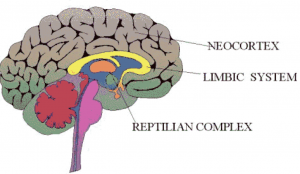
The neo-cortex, what we call the Human brain, is the new kid on the block. It is thoughtful, usually rational (but only as good as its information). It is also slow. Gathering evidence, weighing options and possibilities takes time. It tends to find a good solution, but usually one of the older sections of the brain has a decision all set to go before the neo-cortex has fully explored the problem.
Despite its slowness, its capacity for self-delusion and the ease with which it can be hijacked, the Human brain is extremely powerful. The Human brain solves problems. That’s what it does.
Using abstract reasoning (something the Lizard can’t comprehend) and juggling symbols (something the Monkey often can’t distinguish symbols from what the symbols represent—the probable basis for hypnosis and much of primitive magic) the human brain brings relatively new and unheard-of powers to solving problems:
How do we get these supplies over the border? Why isn’t the car starting? What do these symptoms mean? How do I reach my goal?
Only the Human mind can understand an abstract goal and work towards it. The Monkey and the Lizard, despite their strengths, are purely reactive.
The Lizard, Monkey, Human: Interaction
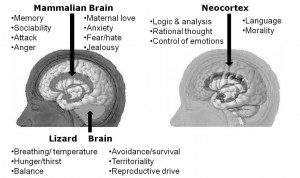
The Lizard, the Monkey and Death
The Lizard is only concerned with survival and outranks the Monkey, so how, as mentioned earlier, can there be soldiers? Why doesn’t the Lizard keep people from getting into the position of choosing between status and survival?
Because the Lizard cannot deal with abstract concepts. The idea that a mortar might hit you has no meaning, no immediacy to the Lizard. Once the Lizard has heard the whistle and seen an explosion, the example becomes real.
Then, though it might run, it also learned that the training worked. Once the lizard trusts the training, you can get a hyper-efficient soldier.
We like to think that our Human mind is who we really are. We like to think that we spend a lot of time there. Get over that.
The Lizard and the Monkey both work at a level below words. You can think of it as subconscious. Words are symbols, imprecise and slow. The Human mind is the master of words and symbols. Words have great power in explaining our actions to others. And to ourselves.
Research has shown, very consistently, that in many cases decisions are made subconsciously before the conscious (Human) brain has even finished evaluating the question.
If someone asks, “Which of these shirts do you like best?” Your subconscious mind will have chosen one before your conscious mind really starts to compare them. When you are asked why you chose one, your conscious mind will have an answer—an answer completely invented well after the decision was made.
Much of the time spent in our Human mind is spent making up reasons for what we already believe or have already decided. Sometimes we are explaining it to others. Often we are explaining it to ourselves. As long as there is no friction, as long as our explanations work well enough that our map of reality isn’t obviously whacked, our brains don’t care if our explanations are accurate.
That’s right. We only care if we are lying to ourselves if it gets us in trouble later. Frankly, the Monkey and the Lizard don’t give a damn about explanations.
You know this. Think of a time when someone made an incredibly stupid decision. Didn’t that person have a very reasonable sounding explanation? That’s the Human covering for the Monkey. Now think of a time when you made an incredibly bad decision…
Skilled fighting, self defense training, is a very human brained activity. Good training is logical. It works.
Unfortunately, the lizard doesn’t believe in training. Which means that on the edge of survival, you won’t use your skills. the lizard will push the human away, “Back off, kid, adults be talkin’ now. I been handlin’ this since T rex roamed the earth…”
Usually, the natural reactions have to fail before the hindbrain will relent and let you use the trained skills. If and when that happens, however, and when the hindbrain begins to trust the training… the hindbrain will back you a hundred percent and you will come to fight with both the skill you have trained and your efficient essence as an animal. that is levels beyond what most people have ever experienced, but it is incredible.
Except, if your monkey brain is triggered. Which it often will if you are facing another human. The monkey will not necessarily recognize a potentially lethal assault situation. It will see another human being. It will likely (unless you have ben raised or trained to not see people you don’t know as humans) want to respond as if this was an in-house problem. Which means the monkey will instinctively not injure (because that will weaken the tribe). The monkey will posture– trying to look big, squaring up, flexing muscles, possibly the worse possible way to stand in a fight. And when the monkey does hit, it will hit to communicate.
Video Links
Wrap Up #1: Communication, Violence and the Triune Brain
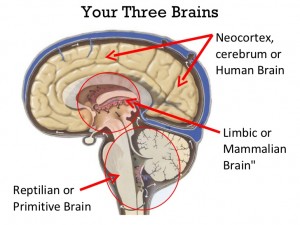
First of all, don’t get all weirded out by the triune brain theory. Yes, most psychologists don’t recognize its validity (always be suspicious of books on the brain written by famous astronomers) but it is a model that works and helps make other concepts easy to grasp.
Here goes:
There are three levels of your brain and they go to violence for entirely different reasons and, in most cases, the types of violence they trigger are completely different.
At the oldest level of your mind, the part that we share with most vertebrates (and hence we call it the Lizard Brain in Conflict Communications) violence is triggered by a fear of immediate death. This is the classic fight/flight/freeze reaction and freezing, (not fighting) is the most common. The fighting usually starts, in the animal world and in ours, when the threat actually bites. It is a deep part of your brain. It is not a part touched by your intelligence, your beliefs and knowledge of strategy and tactics or your training. If this level is triggered, it will be the blind flailing and maybe biting of a panicked animal. None of your skill will come into play.
Video Links:
Wrap Up #2: Communication, Violence and the Triune Brain
We spend most of or time in our social/emotional brains. We think we are being logical and thoughtful. In reality, we are trying to stay in the good graces of an imaginary tribe and make sure that things never change (more on this a little later). The violence at this level rarely gets physical, when it does it is (with only two exceptions) designed NOT to injure. Social violence is all about sending messages: You are not one of us. You broke the rules. This is my territory. Treat me better. I am superior to you. Aren’t I cool?
Because of that, social violence has rules. It is designed not to injure (seriously, people, the over-hand punch to the top of the skull that even trained people tend to open a Monkey Dance with is far more likely to hurt your fist than the other monkey.) It requires the message to be acknowledged. That’s a big one. From spanking to execution, punishment violence requires a statement of remorse or our (the punisher’s) monkey brain is not satisfied and we want to escalate. When someone backs down from the dominance game at the lower levels of the MD but then says something insulting as he walks away, the dance is back on and worse.
This drives a lot of the way social violence happens: there must be a justification, and the threat will get in your face screaming insults hoping you will scream one back so that he can blame you. It starts eye-to eye (or in punishment violence sometimes in a submissive posture). The violence escalates from pure social (talk, from gossip to insults to threats) to display and then to pain, then to cosmetic damage. Almost never to serious injury or death. When it does go to death (only two types within the tribe) it is savage, a venting and a display. It is still communication.
Wrap Up #3: Communication, Violence and the Triune Brain
Almost every aspect of fighting this way is inefficient, if not stupid. Being in front of the guy? Using techniques that do minimal damage? Letting him set the end-game by submission signals?
This is the default value. Our minds spend the most time here. In almost any conflict with another human we will instinctively and unconsciously default to this value. It takes an act of will or experience to NOT fight socially. I have yet to see a training that overcomes this instinct (though many say they do– look at videos of force on force training from almost any school and you will still see these defaults.)
The human brain solves problems. It is intelligent, wise and can make the world a better place. Humans, despite their beliefs, spend almost zero time in this part of their brains. “No, not me!” Really? Everyone has a sure-fire plan to be (fill in the blank, rich or famous or solve a major problem). Almost no one does it. And the plans are good. If you were to make a plan (human brain) and simply execute it, you could make your life better at every level. The mechanisms are well known (read “Think and Grow Rich” for the blue print). They are extremely reliable and effective. Very few people do them.
Because everyone has a voice in the back of the head saying, “That will never work. Who do you think you are? What if you fail? People will laugh. What if you succeed? Your friends will resent you.” That voice is the Monkey Brain and its one goal is to preserve your place in a tribal structure that went extinct thousands of years ago. The monkey brain is older, more powerful and trumps the human brain.
This post isn’t about self-improvement, however. It’s about the flavors of violence.
Violence coming from the human brain is about solving problems. It is about gathering resources as safely and efficiently as possible. Your monkey brain wants to end the fight with the other monkey in a position of submission. Your human brain knows to start a fight with the other monkey in a position of helplessness. Violence from this level is not about winning. It is about subduing or destroying and there is no value in the other monkey knowing who did it or how. If they know how or who, you have given up information. You human brain knows that it never serves you to give up information.
(And right now as you feel yourself come up with counter-examples and what-ifs, taste the feeling in your brain. That is the Monkey, your limbic system, chattering using logic that sounds valid so that you can discount information that might weaken it. Savor the feeling so that you can recognize it later.)
Video Links
Wrap Up #4: Communication, Violence and the Triune Brain
Human level violence is quick, efficient. Close/hard/fast/surprise.
The resource/victim/problem never gets a chance. Either physically or mentally (a well timed threat works just as well as physical violence with fewer complications) the action is literally overwhelming. It is never about the threat as an individual or person. It is about solving the problem. Getting money for drugs to a robber or serving a high-risk warrant for an entry team.
Most people never, in their entire lives, break out of the grip of their own monkey brain to experience this. They know they can. They know how to. Some are told their training is all about this. Saying the words is one thing. Practicing the techniques (which boil down to cheating at an astronomical level) and giving yourself permission to do things that violate your monkey protocols… without those pieces it’s all just words.
You can utterly destroy bigger, stronger and better trained people… but you can’t outfight them. Those are qualitatively different things. And as long as you are in your monkey brain and can’t flip the switch (to either human for skill or lizard for ferocity, or both for something really special) you WILL be trying to fight as communication and, against a predator, you will lose.
Video Links
Rory Miller

“Force is a form of communication. It is the most emphatic possible way of saying “no”. For years my job was to say no, sometimes very emphatically, to violent people. I have been a Corrections Officer, a Sergeant, a Tactical Team member and a Tactical Team Leader; I have taught corrections and enforcement personnel skills from first aid to physical defense to crisis communication and mental health. I’ve done this from my west coast home to Baghdad. So far, my life has been a blast. I’m a bit scarred up, but generally happy.”
Erik Kondo

Introduction to the 3 Brain Model for Conflict
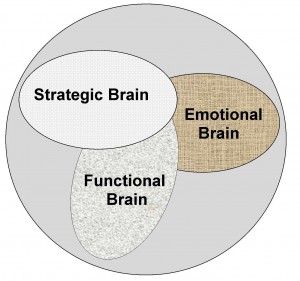
The 3 Brain Model for Conflict (3BMC) is a model based upon the Triune Brain theory created by Paul D. Maclean. The triune brain consists of the reptilian complex, the paleomammalian complex (limbic system), and the neomammalian complex (neocortex), viewed as structures sequentially added to the forebrain in the course of evolution.
The 3BMC consists of the Strategic Brain, the Emotional Brain, and the Functional Brain. These brains are roughly analogious to the neocortex, the limbic system, and the reptilian complex. But there are differences.
The 3BMC is a model to explain and maximize human conflict potential. Unlike the Triune Brain theory, it is not designed to explain the over all functioning of the human brain.
For the purposes of 3BMC, the Strategic Brain is responsible for creating strategy through conscious decision making. The Emotional Brain provides the energy that motivates a person into action, or inhibits the person into a frozen state. The Functional Brain provides lightning fast decision making and automatic accomplishment of instinctive and learned tasks.
Each brain has unique strengths and weaknesses. 3BMC postulates these characteristics to maximize potential and minimize weakness in both training and actual conflict.
For example, the Functional Brain has the unique ability to truly multi-task and manage multiple complex physical tasks at the same time. The Functional Brain allows a person to ride a unicycle, while balancing a plate on his head, while juggling three balls.
The Functional Brain is similar to an internet connection. It’s power can be split multiple times and it is still be able to perform tasks. But the individual performance degrades each time another task is added. While the Functional Brain can perform complex tasks and decision making rapidly, there are many tasks it simply cannot perform regardless how simple. In some respects, the Functional Brain may be thought of as an Idiot Savant.
The Emotional Brain manages the output of emotional energy. While it is possible to have multiple emotions at one time. The emotions are similar to waves. They can add up to create a tsunami or energy or cancel each other out to create a flat line of low energy. In addition, certain emotions are mutually exclusive. It is not possible to both be happy and sad from the exact same stimulus. The Emotional Brain has the ability to generate a tremendous amount of motivational energy or suck up a huge amount of the entire brain’s resources.
The Strategic Brain is the planner. It creates the strategies and is constantly looking for opportunities to defeat the opponent.
The Strategic Brain is the reason a person is able to defeat an opponent that is stronger and faster. The Strategic Brain outsmarts him and decides to use a weapon. But the Strategic Brain is slow to react and make decisions. It also can only concentrate at one task at a time. That is why Strategic Brain actions need to follow one after the other. They cannot happen at the same time.
Depending upon the circumstances, the 3 Brains may all work together, against each other, independently, or some variation of the previous states. Which brain is dominant at any given time changes from stimulus to stimulus and from person to person. A stimulus that may invoke minutes long Emotional Brain dominance resulting from extreme terror in a teenage girl may invoke a momentary Functional Brain trained response from a professional soldier. Meanwhile the Strategic Brain of a bystander may be slowly pondering what exactly is going on.
The generally accepted theory is that the Reptilian complex is responsible for self-preservation, aggression, and the Fight or Flight response. As a result, fine motor skills will diminish and only gross motor skills will be useful in a combat situation.
Most martial artists and combatives practitioners seem to acknowledge this fact. But, then they tend to go right back to training and fighting in whatever style and using the techniques they like the best. They also tend to instruct their students on their personal favorite techniques without taking into consideration the students differing physical and psychological makeup.
The 3BMC states that the brain system is constantly transitioning from one state to the other. Each state has a different order of dominance of the three brains for varying lengths of times from split seconds to minutes. And even when subordinate, each of the 3 Brains is busy working on accomplishing some task. Therefore, when the 3 Brains are working together at maximum capacity the entire brain system is capable of multi-tasking and rapidly handling complex tasks. When the 3 Brains are completely out of sync, the entire brain system can become stuck in a catatonic state.
In terms of combat, it is not enough to simply say that the Reptilian brain automatically takes over and handles the situation. The 3BMC goes further and states that the Functional Brain becomes momentarily dominate subject to the interruptions of the Strategic Brain. The actions performed by the Functional Brain are heavy influenced by the emotional energy generated by the Emotional Brain and the effects of the prior training that permanently altered the skills of the Functional Brain.
What all of the above means is that the exact same stimulus can have a widely varying effect on different people. This same stimulus can produce a varying effect on the same person over different time periods. It depends upon how the persons experiences and learning have changed the responses of the 3 Brains.
Video Links
The Paired Opposite Emotions of the Emotional Brain
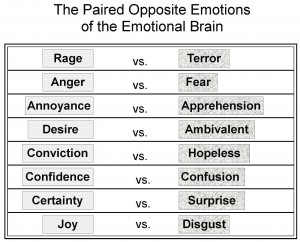
The above emotions are paired opposites because they are mutually exclusive in most instances. For example one stimulus can not invoke the emotions of both confidence and confusion at the EXACT same time.
While there are other emotions, these emotions are the ones most invoked in situations of interpersonal human conflict.
The emotions are centered in the Emotional Brain which is roughly equivalent to the Limbic system, mid-brain, or mammalian brain. The emotions can also be thought of as emotional energy. The emotions both produce energy in the form of motivating physical action and use energy in the form of taxing the resources of the entire Three Brain Model for Combat.
Each emotion emits and uses a different amount of energy. Rage and Terror both emit and use a large amount of energy, while Certainty and Ambivalent emit and use less. When the Emotional Brain uses less resources there are more resources available to be used by the Strategic Brain and the Functional Brain.
The Emotional Brain Proximity Principle

In a hand-to-hand physical conflict, the proximity and distancing of one combatant relative to the other is determined foremost by the combatant’s Emotional Brain despite causing a detriment to his tactical application of technique.
For example, as one combatants Emotional Brain desire to cause injury to the other increases, he will close the distance between himself and his opponent until he reaches a position of emotional equilibrium. Conversely, as his desire to cause injury decreases or is replaced by fear he will seek to place more distance between himself and his opponent.
The result is that the combatants will rarely position themselves optimally for the application of the most effective tactic or technique. They will place themselves where their Emotional Brain wants them to be as opposed to where they tactically should be. This situation has the potential of causing the Strategic Brain, Functional Brain, and the Emotional Brain to be at odds with each other.
For example, the Strategic Brain may realize that when an attacker has a club it is best to be very close or very far away. But the Emotional Brain may not have the Conviction to close the gap, and also may have too much Anger to move back sufficiently. Therefore, the Emotional Brain may place the person in a position that is too close for the Strategic Brain to respond to an attack, and too far for the Functional Brain to “sense the attack”.
Another example is when an emotionally angry man armed with a firearm is approached by a man with a knife. The presence of his loaded fire arm gives the gun wielder confidence. His aggravated Emotional Brain wants to move forward toward the man with thr knife. Without the emotional pull of anger, his Strategic Brain would tell him that he is getting too close. But his emotions of confidence and anger bring him beyond what would be considered a tactically safe distance.
A third example is application of control techniques that require close contact and sticking pressure with the other combatant. If one combatant is fearful of the other, despite his Strategic Brain’s and Functional Brain’s knowledge of where to properly position his body, he will place himself outside of the most effective radius to perform the recalled technique.
In an in-fighting situation, an angry attacker will continue to move closer to his opponent until his Emotional Brain reaches the desired positioning. If the opponent then attempts to bring the attacker even closer, the attackers Emotional Brain response will be to pull back from the opponent. It is a this exact moment of pulling back that the attacker’s Emotional Brain has switched from IN to OUT, from Anger to Fear, from attacking to defending.
This is the moment for the opponent to unleash a furious counter attack in order to exploit the attacker’s momentary weakness. If the opponent is able to take advantage of this moment, he should be able to create an increasing spiral of fear that will cause the attacker to retreat further and thus create more opportunity for his opponent.
The Combatant's Continuum
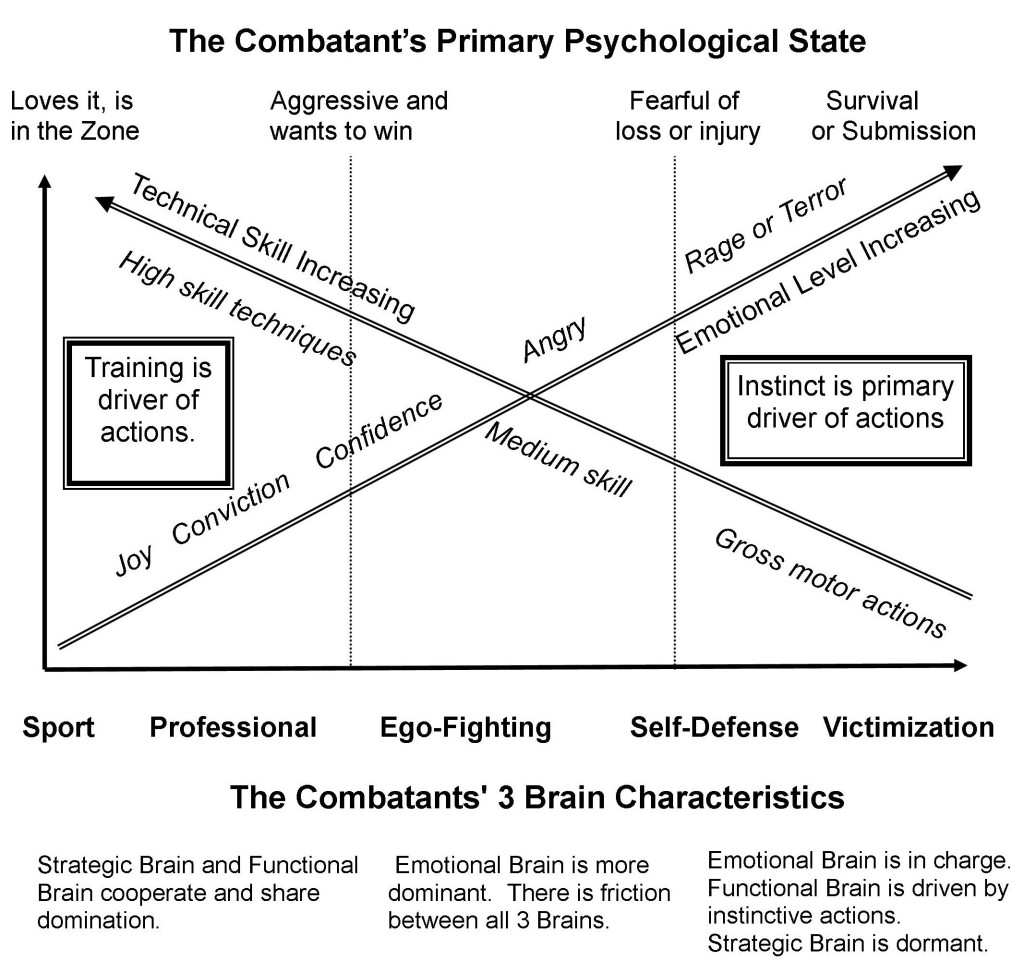
The Combatant’s Continuum is a model designed to explain the effect of a fighter’s psychology during both a single "fight" and an entire spectrum of "fights". It is based upon the following premises:
1. The ability of a combatant to execute trained skills and techniques decreases as his Emotional Brain becomes more dominant - either more fearful or more angry.
2. The technical/skill level of exhibited in sport fighting in general is higher than ego fighting. The technical/skill level exhibited in ego fighting is higher than exhibited in self-defense.
3. The sport fighter’s Emotional Brain becomes more dominant as the sport fighter becomes fearful of losing the match.
4. The emotional level of sport fighting in general is less than ego fighting which is less than self-defense.
5. At the highest skill level of fighting, the fighter’s Functional Brain and Strategic Brain transition smoothly back and forth in dominance. The Emotional Brain emits Confidence, Conviction, and Certainty. The actions directed by the Functional Brain and the Strategic Brain are the result of long term practice and experience.
6. This state differs drastically from an extreme level of active physical self-defense where the combatant’s Emotional Brain has switched from Fear/Terror to Anger/Rage. This switch has been initiated by his Emotional Brain’s desire to survive. The Functional Brain is dominant and executing instinctive survival actions.
Related concepts:
7. The ego is associated with fear of loss and progressively lower skill levels.
8. The so called “aggressive killer instinct” is not associated with the absolute highest skill level.
9. It is the “love for the process” that brings about the absolute highest skill level.
10. Relaxation during a sport competition is a product of both having confidence, conviction, and joy combined with having a higher skill level than one’s opponent.
11. The fearful emotions will prevent the combatant from obtaining the highest skill level.
By using this model, a combatant can make sense of all varied and sometimes conflicting advice on how to be a fighter. He can also use it to analyze what went right and what went wrong during any particular fight or time period in the fight.
The two emotions of fear and anger create weakness. Experienced fighters will create these emotions in opponents. Anger is the Ego which is also about “fear of loss” in this case it is known as pride. Anger is incompatible with “relaxed poise”. Fighter’s will talk in terms of both the importance of “the killer instinct”, “wanting to destroy the opponent” and also being “calm and relaxed”.
It appears that this advice is contradictory unless you consider that it all depends upon who the opponent is, what type of fight it is, and where the fighter is along the combatant’s Continuum.
In other words: depending upon your skill level, the skill level of your opponent, the outcome (do you lose or do you die?), your physical attributes, your opponents physical attributes, etc:
- sometimes you need to be calm and relaxed,
- sometimes you need to want to destroy your opponent,
- sometimes you need to have no emotion,
- sometimes you need to draw upon emotion created by the Emotional Brain
- sometimes you need to be consciously thinking with the Strategic Brain,
- sometimes you need to subconsciously use the Functional Brain,
- sometime you are “in the zone”,
- sometimes you can’t get “into the zone”.
It depends upon the circumstances. The Combatant’s Continuum is a model to help explain the circumstances.
Putting it All Together
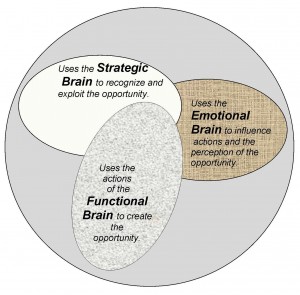
The entire purpose of the 3 Brain Model for Conflict is to use it as a tool to provide a greater understanding of how a person can maximize his or her fighting potential.
The 3 Brain Model for Conflict is intended to encourage a person to develop each of his 3 Brains to it’s full potential. The 3 Brains need to be developed individually. They also need to be trained to work together in harmony. The Functional Brain has the greatest ability for executing physical tasks. But despite it’s incredibly fast speed and decision making, the Functional Brain can only do either what instinct has hard wired or what it has been trained to do over a extended period of time. For example, you may intellectually know how to ride a bike, juggle, or swim. But no amount of book knowledge will enable you to ride a bike. The Functional Brain learns only by doing.
When it comes to conflict, the Functional Brain will be doing the initial work. It is the job of the Functional Brain to weaken, off-balance, and momentarily slow the opponent. Thereby providing the time for the Strategic Brain to recognize opportunity and decide on the next best course of action.
That action could be a devastating blow to a targeted area, a take-down, control move, a disengagement, or other action.
The Strategic Brain is too slow and deliberate to usually create opportunity at a sudden outset of a physical conflict such as an ambush. To try to do so, would mean forcing the action, a recipe for failure.
That being said, the Strategic Brain is needed to end the fight. The typical Functional Brain doesn’t know how to end the fight because it hasn’t enough actual or training experience doing it. Actual devastating strikes and attacks to vital areas cannot be trained by repetition It is too dangerous and impractical. Therefore, these actions are trained by the Strategic Brain via simulation.
The Emotional Brain provides the energy and motivation for actions to happen. A person’s Functional Brain may know how to walk along a six inch wide beam. But if the beam is located hundreds of feet in the air, it is unlikely that the person will attempt it.
The Emotional Brain will stop the person from trying. Even if the person is a highly trained gymnast, if he or she has a fear of heights, it is doubtful that any amount of convincing from the Strategic Brain will be enough.
The Emotional Brain also decides whether the actions recalled and executed will be trained or instinctive. A joyful or calm Emotional Brain leads to smoothly functioning trained actions.
A terrified or engaged Emotional Brain leads to spontaneous instinctive actions. These actions could be entirely appropriate for the circumstances, or they could be the worst possible. They is no way to determine. Therefore, the Emotional Brain must be conditioned (trained) and optimized along with the other brains.
Video Links:
The 3 Brains Ride a Bike
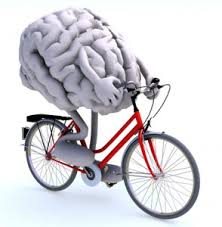
Before looking at the 3 Brains in terms of interpersonal human conflict it is useful to examine them in terms of something almost everyone can related to - riding a bike.
You are happily gliding down a steep hill on your bike in the city. Suddenly you realize that your brakes have failed. You are accelerating down the street towards a busy intersection and you are unable to slow yourself down.
While your Functional Brain is controlling the operation of the bike, your Strategic Brain frantically tries to determine a solution to the problem. When the brakes first failed your Emotional Brain transitioned from joy to apprehension and it is now moving towards fear.
You hit a pot hole in the roadway and almost fall. But the lightning fast reactions of the Functional Brain keeps the bike upright. The Functional Brain is focused on riding the bike. Left in control it will drive the bike straight through the intersection. But your Strategic Brain knows better. It identifies the impending danger and has determined that you need to dump the bike on it’s side to stop. The pot hole was the perfect opportunity to let the bike fall. But your Emotional Brain was too fearful to commit to the fall and your Strategic Brain was too slow to take advantage of the opportunity.
Your 3 Brains are in a state of disharmony. Your Strategic Brain and Emotional Brain are in direct conflict. Your Functional Brain continues to keep the bike upright and headed down the hill towards the dangerous intersection despite the impending danger. At some point, your Emotional Brain’s fear of falling will be overcome by it’s greater fear of colliding with the fast moving cars in the intersection.
At that point your Strategic Brain and Emotional Brain will agree on a course of action. Your Strategic Brain will take over operation of the bicycle and you will either consciously dump it on the street, or you will ride it into an obstacle to stop the bike.
Alternatively, your Emotional Brain will be so terrified that your Strategic Brain becomes dormant. In this situation, your Functional Brain will attempt to ride the bike directly through the intersection. The Functional Brain knows how to ride a bike, but it doesn’t know how to just let it fall.
As you come to the intersection, you see a car coming directly towards you. Your Functional Brain and Emotional Brain react as one. The overriding instinctive reaction is to protect your head. As your hands fly up to your head, you lose control of the bike. You fall and slide through the intersection barely missing the car which passed in front of you a split second earlier.
As you come to a stop, your Emotional Brain is filled with joy. You survived. Your Strategic Brain wakes up and assesses the situation. Your Functional Brain focuses on the mundane tasks of getting up and walking away.
The end result of the experience is different for each brain. The Functional Brain didn’t learn anything. The Functional Brain needs lots of repetitions to learn. The fall was just a fall. The Strategic Brain now has new knowledge related to the experience for future decisions. But for the most part, the Strategic Brain already knew how to handle the situation. It was just unable to put it’s knowledge into a plan and then execute the plan quickly.
The Emotional Brain is the one that has been effected the most. It has learned what the experience of having no brakes on a steep hill feels like. It has learned either what a controlled fall feels like, or what an out of control fall feels like. In either case, the Emotional Brain now has a concrete experience to draw upon for future situations. Some people consider this learning to be emotional “conditioning”.
The Professional Fight
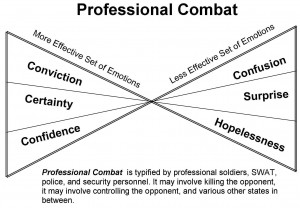
The scenario of the perfect fight provides an idealistic model for how the 3BMC applies to a conflict situation. In this scenario, the “Defender” is approached by the bad intentioned “Offender”. The Defender’s Strategic Brain makes a threat assessment. Due to his prior experience and training, the Defender determines that he can handle the situation. As a result, the Defender’s Emotional Brain feels certainty, confidence, and conviction and emits positive motivational energy. The defender’s Functional Brain is put on standby and is ready to take over.
The Defender’s Strategic Brain tries to defuse the situation and to deter an attack verbally. Despite this effort, the Offender attempts an assault. The Defender’s Functional Brain responds to the trigger of the pre-assault cue and launches a split-second counter attack. The lighting fast decision making and response of the Functional Brain takes the Offender by surprise. He is disoriented, off-balanced, and vulnerable.
The Defender’s Strategic Brain now has a moment to evaluate the situation and determine the next best course of action. The decision of whether to execute a take-down, control technique, or lethal blow can be made by the Strategic Brain due to the advantage of positioning and time created by the Functional Brain. The motivation to perform all of the above was due to the positive and highly efficient energy created by the Emotional Brain. The total time involved from pre-assault cue to finish is a few seconds.
Video Links
The Defensive Ego Fight
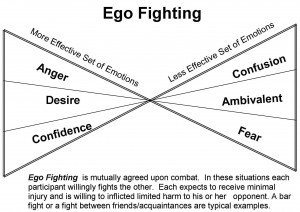
This hypothetical scenario demonstrates how the 3BMC works when events do not go as well as planned. Once again the Defender is approached by a bad intentioned Offender. But this time, the Defender’s Emotional Brain responds with fear and apprehension. This energy causes the Emotional Brain to dominate and the Strategic Brain and Functional Brain to become deeply subordinated.
When the Offender begins his physical assault, the Strategic Brain is too slow to respond to the obvious pre-assault cues. The Defender’s subordinated Functional Brain activates, but has barely enough time to instinctively “flinch” and get his hands up. As the Defender feels the impact and pain of the Offender’s attack, his Emotional Brain becomes switches from apprehension to anger. The energy created by anger drives the Defender into action. His Functional Brain executes instinctive anger related actions such as punching, kicking, and grabbing. The Defender’s prior training and experience many now come into play.
As his Functional Brain successfully executes actions, his Emotional Brain becomes more confident emitting positive energy. Eventually, the Defender is able to get the upper hand on the Offender. As in the previous scenario, his Strategic Brain now has the positioning and time to evaluate his next move, a take-down, control technique, or lethal blow. This scenario took considerably longer and involved much greater risk of the Defender receiving an injury than the previous Professional Fight.
Video Links
The Self-Defense Fight
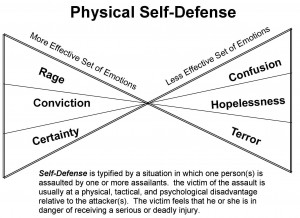
This third hypothetical scenario shows what happens when the fight is not a fight, but actually self-defense. The Defender is approached by the bad intentioned Offender. The Defender’s Strategic Brain’s threat assessment causes the Emotional Brain to jump to Fear. The Functional Brain responds to the Fear and waits for a either Flight or Freeze decision from the Strategic Brain or the Emotional Brain.
If the Defender’s Strategic Brain recognizes that the best course of action is to flee and makes the decision, then the Functional Brain will engage and flee. If the Strategic Brain is overwhelmed with Fear, it will become deeply subordinated and do nothing. Therefore, the decision to freeze of flee is made by the Emotional Brain. If her Emotional Brain associates Fear with flight she will run. But if her Emotional Brain associates terror with being still, she will be frozen in place.
When the Offender launches his attack. The Defender’s Emotion Brain goes from Fear to Terror. The Strategic Brain goes dormant. The Function Brain “ducks and covers”.
Reptilian theory postulates Flight or Fight. So where is the Fight? The Defender will not fight if his primary emotion is Terror. Once the Emotional Brain feels and emits Terror energy, his Emotional Brain must switch to Rage in order to Fight. Terror and Rage are mutually exclusive. Therefore, regardless of any previous training or experience, if the Emotional Brain is emitting Terror energy, the Defender will either Freeze or Flee, not Fight. The deciding factor is whether or not his Emotional Brain has learned to associate Terror with Freezing or Fleeing.
Given the previously described situation, the Defender’s only chance to save himself is if his Emotional Brain switches from Terror to Rage. The ability to make this switch is a function of the Emotional Brain’s desire and will to survive. What causes this desire varies from person to person, but it is an emotional attachment to living. Unless motivated to do something else by the Emotional Brain, the Functional Brain will continue to duck and cover, and the Strategic Brain will remain dormant.
Video Links:
Summary of the three hypothetical "fight" scenarios.
The previous scenarios are designed to show how the 3 Brains interact and function in different circumstances. The intent of 3BMC is to create training and conflict methods that capitalize on the strength and minimize the weaknesses of the 3 Brains.
From the scenarios described, each of the 3 Brains had a different degree of dominance and effect on the outcome.
In the first situation (Professional), the Emotional Brain had the minor role, while the trained Functional Brain provided the bulk of the opportunity for the Strategic Brain to finish the job.
In the second case (Ego), the Emotional Brain had a both hindering and helping effect on the Strategic Brain and Functional Brain to inefficiently complete the task.
In the final case (Self-defense), the state of the Emotional Brain determined the outcome. Both the Strategic Brain and the Functional Brain were overwhelmingly influenced by the energy of the Emotional Brain.
The Functional Brain

The Functional Brain is similar to an internet connection. It’s power can be split multiple times and it is still be able to perform tasks. But the individual performance degrades each time another task is added.
While the Functional Brain can perform complex tasks and rapid decision making, there are many tasks it simply cannot perform regardless how simple. In some respects, the Functional Brain may be thought of as an Idiot Savant.
The Emotional Brain

The Emotional Brain manages the output of emotional energy. While it is possible to have multiple emotions at one time. The emotions are similar to waves. They can add up to create a tsunami or energy or cancel each other out to create a flat line of low energy.
In addition, certain emotions are mutually exclusive. It is not possible to both be happy and sad from the exact same stimulus. The Emotional Brain has the ability to generate a tremendous amount of motivational energy or suck up a huge amount of the entire brain’s resources.
The Strategic Brain

The Strategic Brain is the planner. It creates the strategies and is constantly looking for opportunities to defeat the opponent.
The Strategic Brain is the reason a person is able to defeat an opponent that is stronger and faster. The Strategic Brain outsmarts him and decides to use a weapon. But the Strategic Brain is slow to react and make decisions. It also can only concentrate at one task at a time. That is why it is impossible Strategic Brain actions need to follow one after the other. They cannot happen at the same time.
Erik Kondo

If you think self-defense is mainly about physical fighting or that only those with a long history of personal involvement in violence have an opinion that is worthwhile, feel free to skip my contributions.
While I do have multiple years of training background in a variety of martial arts, particularly Small Circle jujitsu, my focus in on helping the average person make sense of self-defense.
I see self-defense as an extension of personal safety which is an extension of how you live your life. My goal is to help people learn to minimize the negative consequences of aggression and obtain peace of mind through developing better understanding, critical thinking and judgement in times of interpersonal conflict.